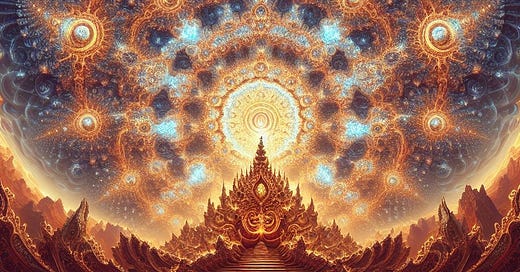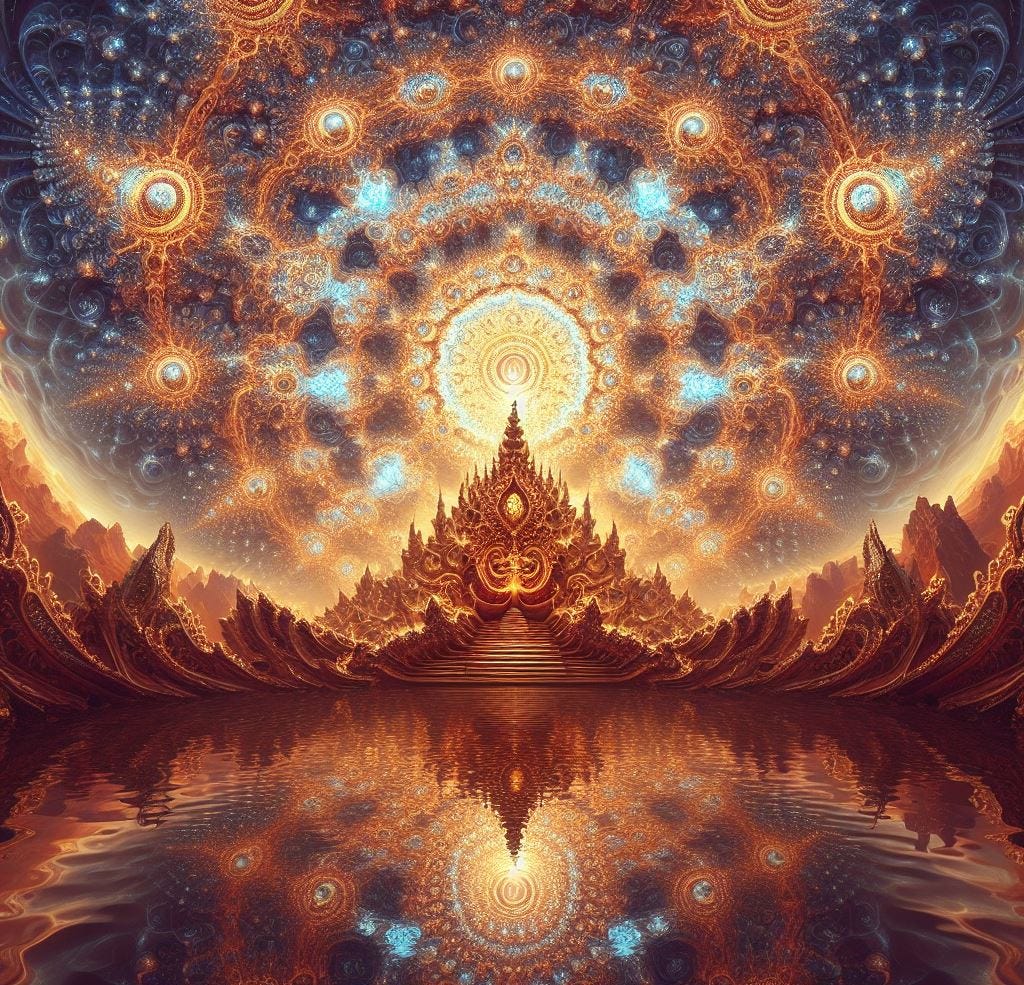Fractals of the Infinite: Vedantic Wisdom and Cosmology
How Concepts Like Viskvatomukham and Sarva-gatah Parallel Mathematical Principles of Self-Similarity and Interconnectedness.
The Vedantic notion of Visvatomukham, meaning "with the face on all sides", shares deep resonances with fractal geometry's vision of the universe. Viskvatomukham conveys that the divine reality shines through all manifested forms. This echoes how fractals reveal self-similar patterns across scales - each microcosm reflects the macrocosm.
The Upanishads proclaim "From fullness, fullness comes. When fullness is taken from fullness, Fullness remains." This declares that infinity perpetually pours forth from the eternal source, which is never depleted. Mathematically, fractals also iterate endlessly to generate immense complexity from simplicity. The fundamental pattern is preserved within each iteration.
In Vedanta, Brahman is understood as the fundamental reality that transcends and expresses the diverse universe. Fractals symbolise this interplay of unity and diversity, the enfolding of the whole within each part. They depict the wondrous interbeing of part and whole.
The theory of the universe as a fractal dodecahedron is a proposal that the shape of the cosmos is not infinite and flat, as the standard model of cosmology assumes, but finite and curved like a twelve-sided polygon. This idea was suggested by some cosmologists who tried to explain the anomalies in the observations of the cosmic microwave background, the radiation left over from the Big Bang. They claimed that a dodecahedral universe could account for the lack of large-scale fluctuations in the temperature of the radiation, which were expected in an infinite and flat universe.
Some of the scientists who worked on this theory are:
Jean-Pierre Luminet, a French astrophysicist and writer, published a paper on the dodecahedral model in 2003;
Glenn Starkman, a professor of physics and astronomy at Case Western Reserve University, co-authored a paper on the dodecahedral model in 2003;
Jeffrey Weeks, an American mathematician and MacArthur Fellow developed software to visualize the possible shapes of the universe.
Fractals are objects or mathematical series characterized by a fundamental property: self-similarity. This means that the fractal is formed by parts which replicate the structure of the whole on different scales. In mathematical terms, a fractal presents scale symmetry: enlarging or reducing parts of the object, one obtains details similar to the entire structure.
Fractals can be created artificially through algorithmic iterations, but they are also commonly found in nature as a result of complex dynamic processes. Let's now analyze 10 natural examples of fractal patterns:
Tree branches - Each little branch seems to reproduce the shape of the tree itself. This is because growth happens through dichotomous branching, each branch dividing into two increasingly slender branches.
River network - The paths of rivers with their tributaries form watersheds with a fractal shape, which appears similar at different scales.
Jagged coastlines - Seen from above, the inlets repeat irregularly the complex shape of the coastline.
Cloudiness - The jagged contours of the clouds, generated by the turbulent motion of the atmosphere, are fractals.
Snowflakes - Each snowflake has an intricate hexagonal structure that exhibits self-similarity.
Coral - The branching of coral into increasingly finer sub-branches is a fractal process of growth.
Romanesco - This cauliflower exhibits fractal spirals with conical tips that self-replicate on decreasing scales.
Spiderwebs - The intricate webs have a fractal structure determined by the spider's way of weaving.
Blood vessels - The branching of the cardiovascular system, from arteries to capillaries, is fractal.
Bronchial tree - The airways of the respiratory system also follow a fractal pattern of dichotomous division. - The air ducts of the respiratory system also follow a fractal pattern of dichotomous division.
Furthermore, we see that the Vedantic vision of Sarva-gatah, (“all-pervading”, “that extends everywhere” or “that fills everything”), the understanding of Brahman as all-pervading, and the fractal perspective both reject reductionism and duality, unveiling the intrinsic unity-in-diversity of existence. Sarva-gatah refers to the omnipresence of Brahman, the Absolute Reality which permeates the entire cosmos while still transcending it. Through recursive self-similarity across scales, fractals mathematically manifest the interpenetration of part and whole. This echoes how the unbounded Brahman wholly manifests in each fragment of the cosmos according to sarva-gatah, the All-pervader. Both worldviews subvert ordinary logic to express higher truths about the totality's irreducible complexity.
Whether through abstract geometry or embodied spirituality, we approach the infinite intricacy of nature's patterning. We touch the divine mystery of the One radiating as the many. Yet this multiplicity is not fragmented but endlessly interconnected, by tubes of flow and recursion, into a seamless tapestry - a fractal dodecahedron flowering from the self-similar seed of Sarva-gatah, the omnipresent origin. Thus diversity complexity and infinity issue forth in resonant harmonies, visibly in fractal modeling, intuitively through nondual insight. Conceptually distinct yet intuitively confluent, these visions beckon us toward wisdom vaster than rationality. They call us to revere the all-pervading fullness that dwells within and shines through every infinitesimal form.
Both Vedanta and fractal geometry exalt direct mystical intuition over rational constructs. Their visions unveil truths that elude reductionist analysis. These worldviews celebrate the intrinsic fullness of reality, the infinite interconnection of all manifested forms.
When we realize Viskvatomukham - that the divine fullness looks through every face - the delusion of egoic separation dissolves. As the Upanishads declare: "When fullness is taken from fullness, Fullness remains." Nothing essential can ever be lost, once we recognize our infinite wholeness. Lack only existed in illusion.
To sum up, Viskvatomukham and fractal cosmology inspire awe at existence's hidden glory. They teach that diversity emerges from and returns to a unitary being. All seeming fragmentation is temporary. At the deepest level, the entire universe is a single fractal organism, pulsating with divine fullness here and now.
The parallels between Vedanta, fractals, dodecahedral universe and sarva-gatah intimate that diversity and unity arise from one Consciousness. Fractals' self-repeating patterns across scales suggest an innate interconnectivity of all forms, potentially emanating from and returning to a common source. Awakening to our infinite essence, we may realize beyond divisions to our shared ground of being. There we find the unifying Thread that weaves multiplicity into a tapestry, pulsing with the One Presence that embraces all - faintly echoed in sarva-gatah and fractal resonances, for those with eyes to see.
I have woven tales to share, for any who care to read them. My books await you on Google Books. Check also my stories on Medium.com.
I would be honoured if you considered subscribing to the Premium Contents of my Vedanta Substack and leaving feedback, comments, and suggestions both on this page and by writing to me at cosmicdancerpodcast@gmail.com.
Thank you for your precious attention.




